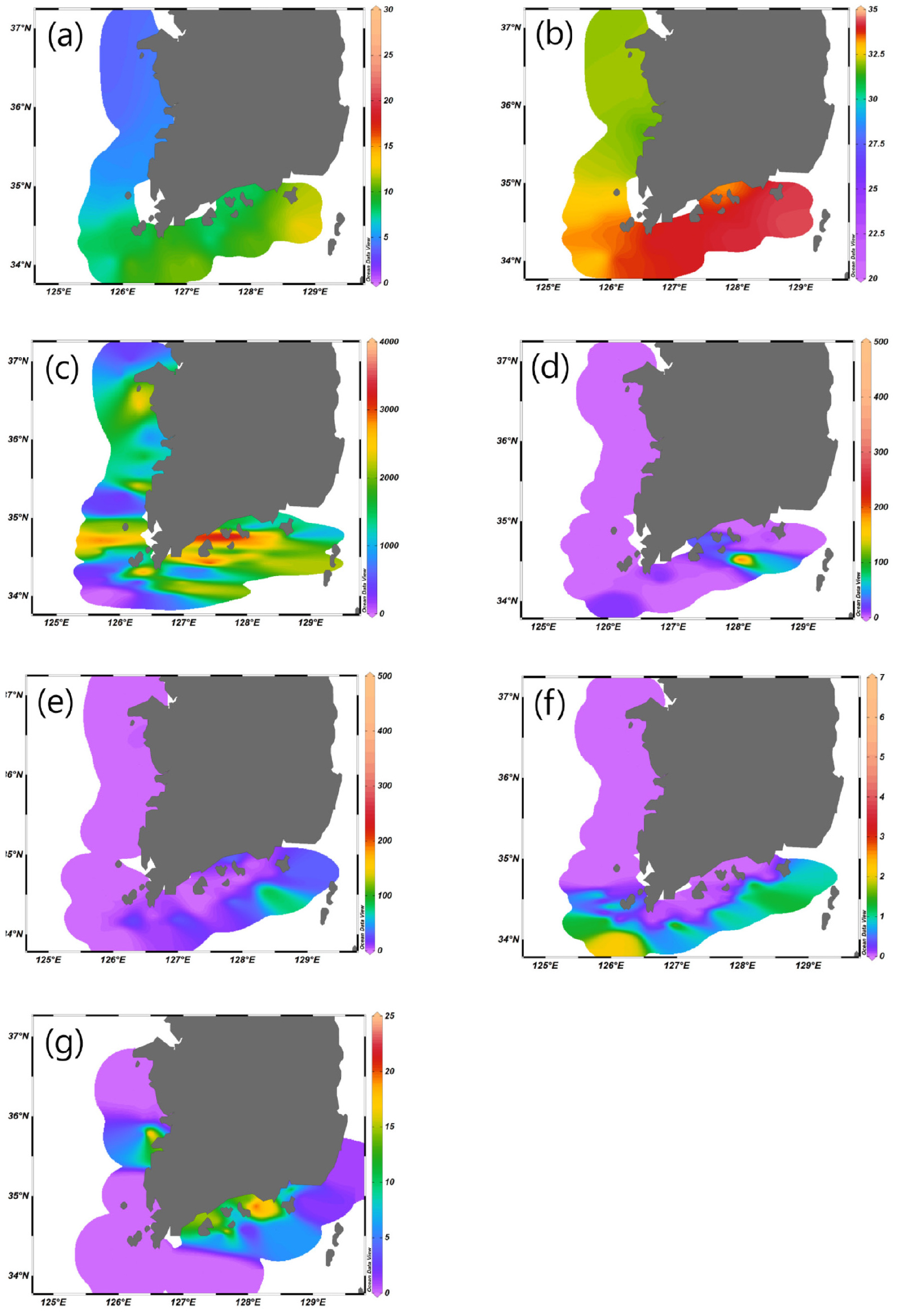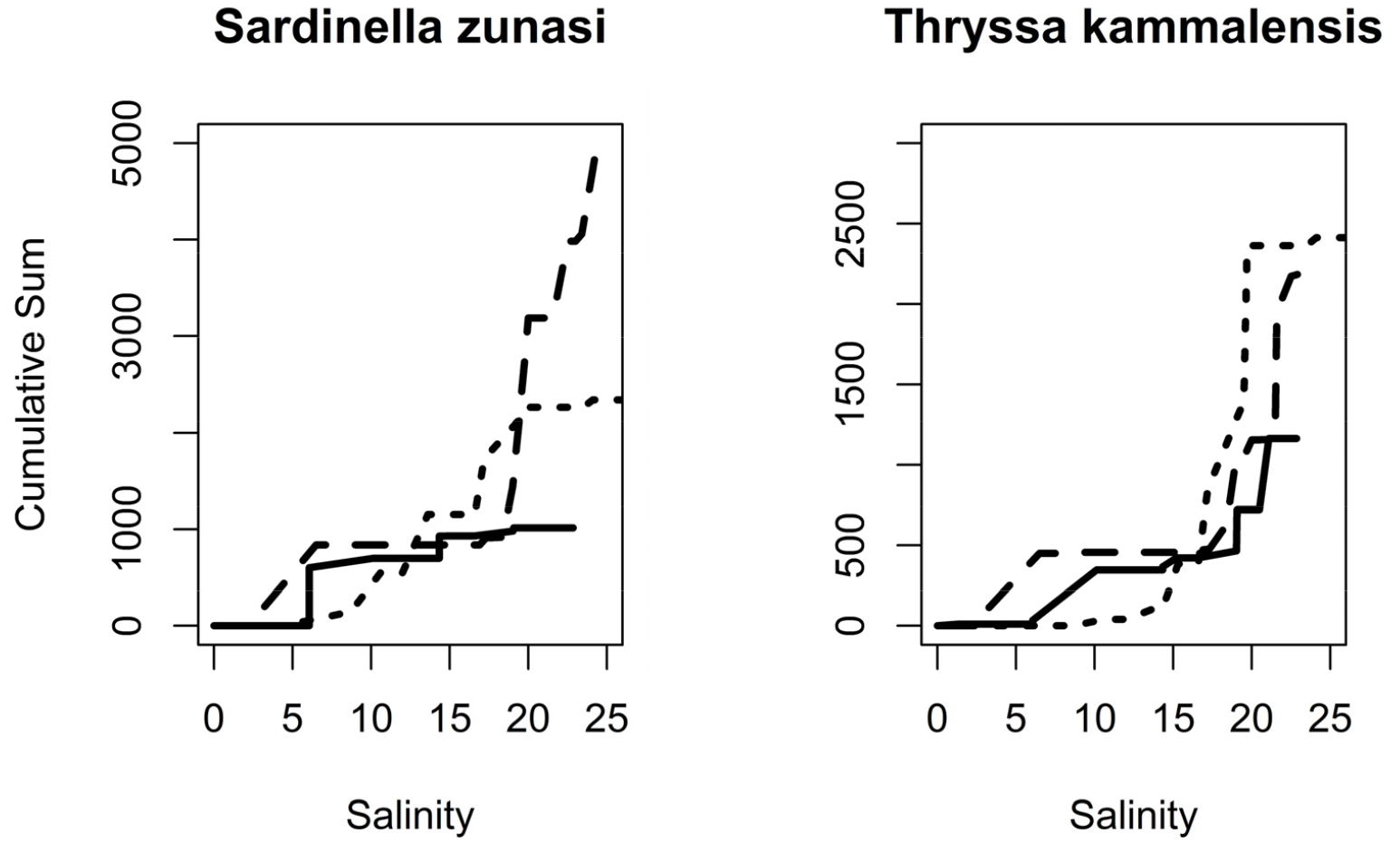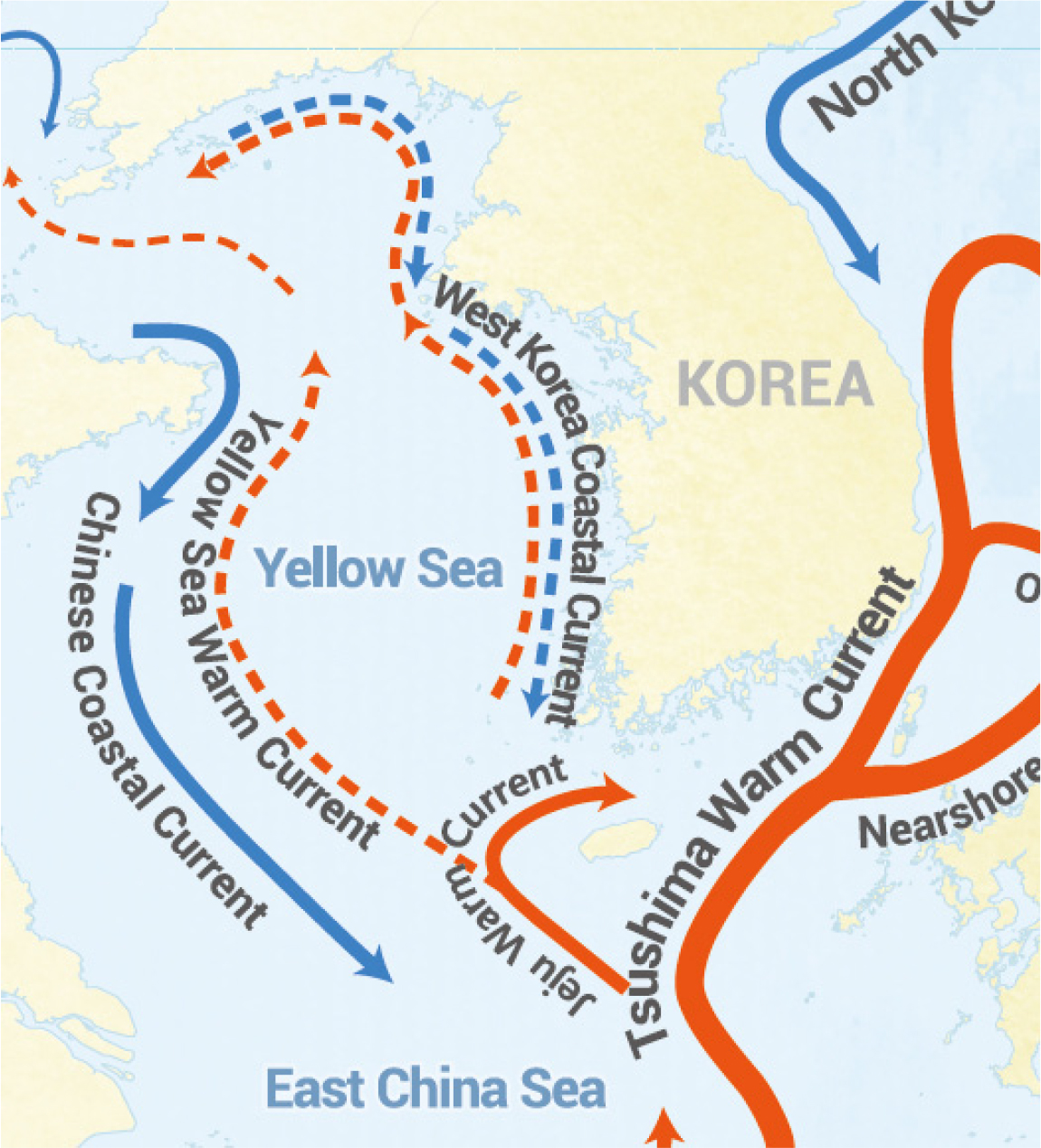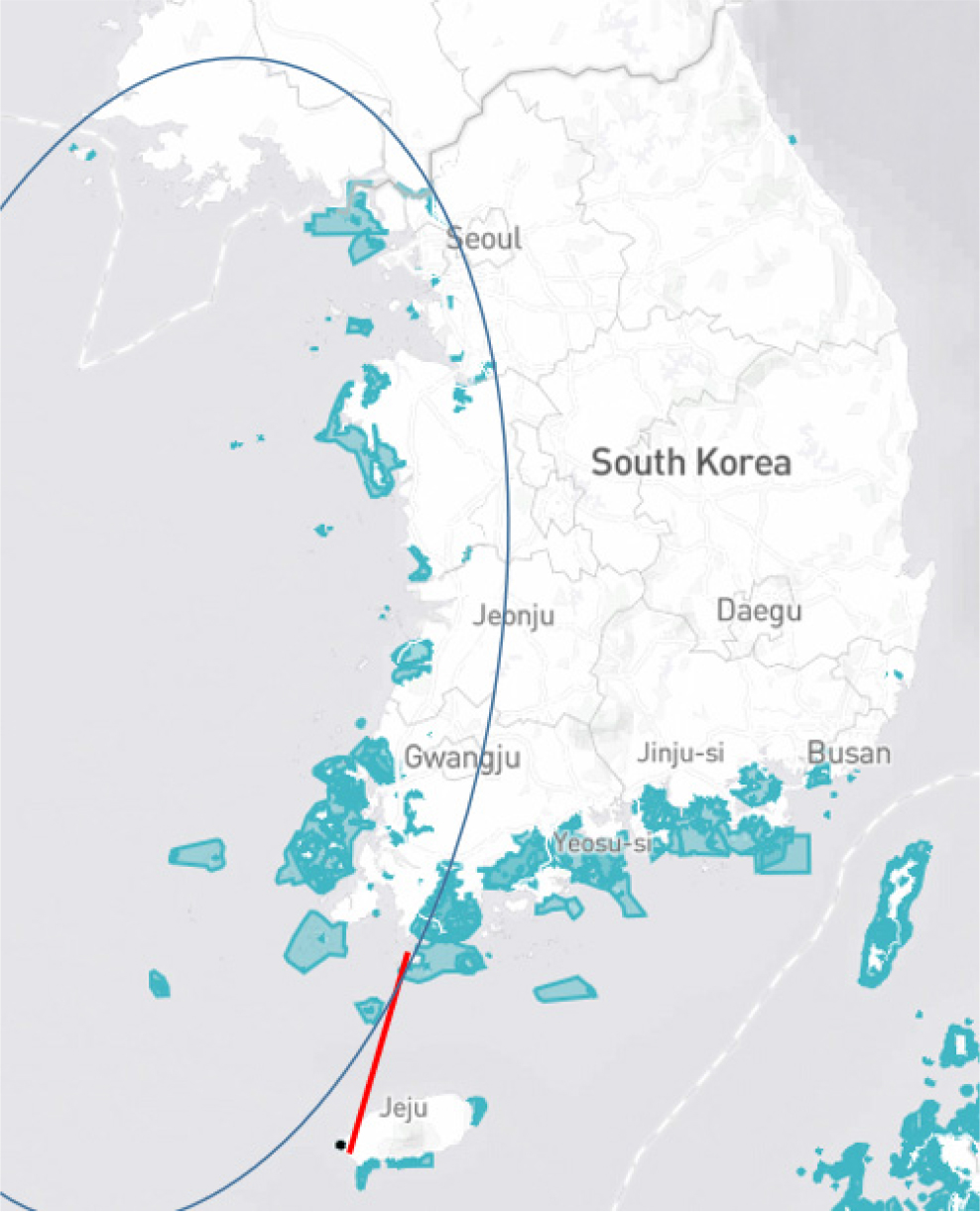1. Introduction
2. Data Acquisition
3. The West Coast of Korea is a Single Distinctive Ecosystem
4. Status of MPAs on the West Coast of Korea within the YSLME
5. MPAs are Physically Connected
6. MPAs are Genetically Connected
7. Disconnectivity of Coastal Habitats
8. Effectiveness of MPA
9. MPAs as a Coastal Ecosystem Management Tool in Korea
10. Conclusions
1. Introduction
Marine Protected Areas (MPAs) are sections of coastal waters that generally expand to an Exclusive Economic Zone (EEZ) where a federal or local government has placed restrictions on human activity. They are generally designated for the protective and conservative management of natural marine waters according to predefined management objectives, which may include the protection of economic resources, biodiversity conservation, and endangered species protection. MPAs can be classified in various ways, and one system categorizes them into marine reserves, fully protected marine areas, no-take zones, marine sanctuaries, ocean sanctuaries, marine parks, and locally managed marine areas (IUCN 2013). Many of these MPAs have varying degrees of protection applied to them depending on the country, so the range of activities allowed or prohibited within their boundaries may vary considerably (Balbar and Metaxas 2019; IUCN 2013; Kelleher 1999).
MPAs have become an essential part of ecosystem management in coastal waters around the world. Both the Convention on Biological Diversity (CBD) and the World Conservation Union (IUCN) have criteria for setting up and maintaining MPA networks. The first edition of guidelines for MPAs was published in 1991, followed by an updated version in 1999 (Kelleher 1999). The guidelines emphasize the following four factors for MPA management: adequacy, representability, resilience, and connectivity (Sciberras et al. 2013). Adequacy means that the sites have the size, shape, and distribution needed to ensure the success of selected species. Representability involves protection for all of the local environment’s biological processes, and resilience indicates the resistance of the system to natural disasters, such as a tsunamis or floods. Finally, connectivity means maintaining population links across nearby MPAs (Sciberras et al. 2013).
However, it is difficult to actually quantify and measure these factors in terms that can be incorporated into management practices for MPA. Each factor deserves a great deal of research, which is one of the reasons there are few studies on the effects of these factors and their consideration in MPA management. For instance, the concept of habitat connectivity may be the most studied among the four factors, yet connectivity has been used as an ecological criterion in only 11% of MPAs globally (Balbar and Metaxas 2019). There is also geographic bias in such connectivity research and applications, which are mostly done in Australia and California. However, there has also been increasing use of connectivity in scientific and management literature over the past decades (Balbar and Metaxas 2019).
The west coast of Korea is in the region of the Yellow Sea Large Marine Ecosystem (YSLME) and is heavily exploited and physically modified (Walton 2010). MPA designation in Korea started with the designation of Marine National Park in the 1960s, and the size and number of MPAs designated on the Korean side of the YSLME have steadily increased over the past decades (Yook et al. 2005). Although there are many policy aspects about the MPAs in Korea (Chae 2012; Choi et al. 2004; Yook et al. 2005; Yook et al. 2014), there are no systemic studies that have specifically examined MPAs with respect to the connectivity and their overall effectiveness for marine ecosystem management in the YSLME. Therefore, in this review, we explore the limited data and studies on the habitat connectivity and effectiveness of MPAs on Korea’s side of the YSLME. We also searched for research gaps that need to be addressed for the assessment of MPAs in this region.
2. Data Acquisition
We searched peer-reviewed papers as well as government or agency reports and webpages (e.g., google scholar) on Korean side of the YSLME. We also used some of our own data that were acquired during the National Marine Ecosystem Monitoring Program conducted by Korea Marine Environment Management Corporation (KOEM) and the Marine National Park Ecosystem Survey Program conducted by Korea National Park Service (KNPS) as necessary. These two programs are comprehensive and cover all coastal waters of Korea, including both water column and sediment environments and associated organisms.
3. The West Coast of Korea is a Single Distinctive Ecosystem
An ecosystem or ecoregion is considered as a unit for management (Spalding et al. 2007) to achieve the long-term conservation of marine resources and sustain ecosystem services in that ecosystem (IUCN 2013; MOF 2021a). In Korea, the MPA includes protection of species, ecosystem, and landscape (MOF 2021a). The YSLME in Korean waters is a single marine ecoregion (Spalding et al. 2007) that is both physically and biologically distinct from other ecoregions surrounding Korea, such as the East China Sea (the South Sea of Korea) and the East Sea (the Sea of Japan). Thus, prior to any discussion of MPA connectivity in the YSLME, it is important that the connectivity and effectiveness of MPA should be examined within this context.
The west coast of Korea is a small area that spans a few hundred kilometers in the north-south direction. It is tide-dominated, and the water mass in the region is distinct from the South Sea of Korea, which is another separate ecoregion that is strongly affected by the Tsushima Warm Current (TWC), which branches out from the Kuroshio Warm Current (KWC) (Fig. 1). The Changjiang Diluted Water (CDW) has a strong influence on only the South Sea of Korea following summer monsoons (Fig. 1). Water mass exchange between the Yellow Sea and the South Sea of Korea is very limited (Naimie et al. 2001). The winter water temperature of the Korean side of the YSLME is lower than in the South Sea and clearly distinct from the South Sea (Fig. 2a). The water salinity is also distinctly lower than in the South Sea (Fig. 2b). The Korean side of the YSLME can be characterized by limited changes of water temperature and salinity, and the physical properties are largely punctuated by regions influenced by large river discharges (Fig. 2c). Light penetration in the surface waters can thus be largely influenced by the sediment loads adjacent to rivers on the west coast (Fig. 2c).
The distribution of major marine organisms also demonstrates distinction of the Korean side of the YSLME from the South Sea (Fig. 2d–g). Some species ranging from the microscopic planktonic to benthic macroorganisms are clearly restricted to the southern coastal waters in their biogeographical distribution. For example, the ichthyo-toxic dinoflagellate and infamous harmful alga Cochlodinium polykrikoides is observed in only the South Sea of Korea during its summer bloom period (Lim et al. 2019). The small cyclopid copepod Oithona fallax is considered a warm-water species and is the dominant taxon around Taiwan waters (Dahms et al. 2015; Wang et al. 2017). They are also present in only the southern part of Korea in the fall and never appear on the west coast in any season.
The shrimp-like macrofauna Eriopisella sechellensis is a seagrass amphipod.
Compared to plankton, benthic organisms are less restricted by geography (e.g., they better adapted to temperature and salinity). They appear on the west coast, but mostly in the southern coastal region (Fig. 2g). They are generally considered a warm-water species and have been reported in only subtropical and tropical regions, such as in Trang Province of Thailand, where large patches of seagrass beds can be found (Satheeshkumar 2011; Wongkamhaeng et al. 2009).

Fig. 2.
Distribution pattern of seawater properties and distinctive organisms present in only or mostly the southern coastal waters of Korea (y-axis is latitude, x-axis is longitude, z-axis is value): (a) Temperature (°C) distribution at 1.5-m seawater depth on a winter day, (b) Salinity(psu) distribution at 1.5-m depth on a winter day, (c) Photosynthetic active radiation (PAR) at 1.5-m depth on a spring day, (d) Distribution of toxic dinoflagellate, Cochlodinium polykrikoides (individual/mL), in summer, (e) Distribution of toxic diatom, Pseudo-nitzschia delicatissima complex (individual/mL), in spring, (f) Distribution of warm water marine cyclopoid, Oithona fallax (individual/m3), (g) Distribution of warm-water marine seagrass amphipod, Eriopisella sechellensis (individual/m3), in summer
Recently, an existing marine conservation law has been amended in Korea for setting up a new management unit called a “Marine Ecological Axis Management” within the YSLME and all Korean coastal waters (MOF 2021a). The term “Marine Ecological Axis” means an axis constructed by connecting important regions or sea areas in order to integrally conserve and manage the marine ecosystem and marine biodiversity and to maintain the continuity of the structure and function of the marine ecosystem. Such adoption of local policy to enhance the habitat connectivity would contribute to better management of the MPA. Seeking international recognition of the concept as an effective management tool for MPA should follow.
4. Status of MPAs on the West Coast of Korea within the YSLME
The current map and designations of MPAs on the Korea side of the YSLME are shown in Fig. 3 and Table 1. MPAs in Korea are broadly distributed in the western and southern coastal waters, and the MPA within the YSLME contributes about 45% of the total MPA in Korea. The MPA within the YSLME is about 5,500 km2 (Table 1), constituting about 10 % of the total national territorial sea area of about 49,000 km2 (https://www.molit.go.kr/ USR/policyTarget/m_24066/dtl.jsp?idx=203). Marine National Park contributes slightly less than 45% of the area of the MPA, followed by the wetland protected area at 25% (Table 1). Fishery resource conservation areas, environment conservation marine areas, and natural monuments comprise the other 30% (Table 1). Large MPA (> 100 km2) associated with the national park is the dominant type of MPA, accounting for 90% by area. Other small areas not included in this list are very small (< 1 km2 in area). They are generally used for the protection of small inhabited and uninhabited islands, which are primarily for migratory birds and scenic views rather than directly protecting marine environments.
Table 1.
Protected areas (PAs) on the west coast of Korea in the Yellow Sea Large Marine Ecosystem (YSLME) region. The area and coverage were drawn from https://mpatlas.org/zones, which composites and disseminates all marine protected area around the world. The MPA within the YSLME accounts for about 10% of the territorial sea waters of Korea and 20% of the waters of YSLME on Korean side
| Type of PA |
Area (km2) |
Percent coverage (%) |
Number of Large MPA (> 100 km2) |
Laws related to MPA | *Level of protection | Notes |
| National Park | 2390 | 43.5 | 2 out of 4 |
Natural Park Law Article 4 | II | Fishing allows |
| Wetland Protected Area | 1360 | 24.7 | 2 out of 7 |
Wetland Protection Law Article 8 | IV |
No habitat alteration |
|
Fishery Resource Conservation Area | 637 | 11.6 | 3 out of 4 |
Fisheries Management Law Article 48 | VI |
No habitat alteration |
|
Environment Conservation Marine Area | 451 | 8.2 | 2 out of 2 |
Marine Environment Management Law Article 15 | VI |
No habitat alteration |
| Natural Monument | 440 | 8.0 | 1 out of 6 |
National Heritage Law 27 | III |
Generally fishing allowed |
| Marine Protected Area | 212 | 3.9 | 0 |
Marine Ecosystem Management and Conservation Law Article 25 | IV |
No habitat alteration |
| Protected Surface | 2 | 0.05 | 0 |
Fisheries Resource Management Law Article 46 | Ia |
No-take, temporary |
*According to IUCN Protected Area Management Categories (IUCN 2013). IUCN Protected Area Categories System classifies MPA into seven levels, from level Ia as the most protected to level VI to the least protected
5. MPAs are Physically Connected
Habitat connectivity is an important concept for setting up MPAs, yet it has scarcely been included in management plans for MPAs. Habitat connectivity is important for ensuring that populations are connected through movement and thus maintain connectivity between each other (Gillanders et al. 2003). Habitat connectivity increases the productivity of fisheries. Studies show a link between fish catch and coastal habitat characteristics (including structural connectivity). Therefore, the regions with high connectivity are of high priority when establishing a network of declared fish habitats (Meynecke et al. 2007).
The scale of movement from juvenile to adult habitats can range from meters to over thousands of kilometers. However, 94% of all the species that have been reviewed have dispersal distances of more than 50 km, and 55% have some degree of dispersal. Therefore, distances of more than 100 km and the global spacing rule (50–100 km) indicate connectivity for 55–94% of the species worldwide as a rule of thumb according to the review by Gillanders et al. (2003). It is difficult to cover whole groups of the organisms of interest for protection by setting up MPAs. Furthermore, the review by Gillanders et al. (2003) is based on fishes from coral reefs, so the results could potentially be biased, but they are still applicable to our MPAs. The distance between MPAs in Korea is far closer than the scale of 50–100 km (Fig. 3).
6. MPAs are Genetically Connected
In addition to physical and structural connectivity, genetic connectivity is also important in management plans for MPAs, and its importance has been gaining greater attention in recent years (Carr et al. 2017; Lowe and Allendorf 2010). Genetic connectivity (also called “gene flow”) is the exchange of genetic material among populations of the same species. It allows for the maintenance of genetic diversity resulting from the movement of genes among distinct populations of a single species, as well as the movement of organisms among these populations (Carr et al. 2017). It can provide insight into demographic connectivity, which depends on the relative contributions to population growth rates of dispersal versus survival and the reproduction of residents (Lowe and Allendorf 2010).
The concept of genetic connectivity applies for all types of organisms from plankton to large mammals. However, it is probably most relevant to endangered or protected species such as marine fish and mammals. No information on genetic connection of endangered fish or mammal is available, so in this brief review we rather focus on common fish species for which genetic studies have been conducted. Fish may be an appropriate group for examining genetic connectivity in this review of the spatial scale of the YSLME. Only a handful of marine fish studies are available, but they all indicate that fish are generally genetically connected within the YSLME. The Pacific cod (Gadus macrocephalus) is an economically important demersal fish. Genetic examination revealed that population in the Yellow Sea has higher genetic differences than three other populations in the East Sea (The Sea of Japan), the Okhotsk Sea, and Eastern Hokkaido (Song et al. 2016). This result suggests that the Yellow Sea population is genetically distinct from other sub-populations of the species in other regions.
There are other results that support the genetic connectivity in fish populations within the YSLME. The small yellow croaker, Larimichthys polyactis, an important fishery species in China and Korea, inhabits coastal waters across the Bohai Sea, the Yellow Sea, and the East China Sea. Song et al. (2016) examined genotypes of 15 highly polymorphic microsatellites in 337 individuals of 15 geographic populations, which were collected from both spawning and overwintering grounds in the Yellow Sea. They found no evidence of isolation by distance, indicating a high degree of genetic connectivity among the different geographical populations of L. polyactis in the YSLME region (Liu et al. 2016).
7. Disconnectivity of Coastal Habitats
Protected species do not reside in only MPAs. Many are in fact migratory and utilize a suite of habitats throughout their life history. They move between MPAs and to other coastal environments, such as estuaries. Thus, in a broad sense connectivity to these important but not protected marine environments is extremely important. This is the reason why MPAs are considered as a network rather than isolated habitats. MPA networks are composed of two or more MPAs that are linked in diverse ways (e.g., biological or institutional) and complement each other. If properly designed, they may offer benefits over single MPA (FAO 2011).
Unfortunately, many estuaries and bays lack proper protection under Korean law. They have been heavily altered with most rivers having dams and gates in the areas of river mouths, thus representing a major blockage for MPA networks. Most estuaries in Korea have been reclaimed with dam construction to hold freshwater supplies for agricultural and industrial uses. For instance, more than 280 dams have been constructed during the past few decades in Chungcheong Province alone (Lee et al. 2015). The massive damming has transformed many important estuarine habitats into what are virtually bay environments around Korea.
Altered freshwater discharge can have greater effects on estuarine hydrography and drastically impact the ecology of estuarine organisms. This occurs by interrupting the flow of organic carbon, changing the nutrient balance, and altering the oxygen and thermal conditions (Friedl and Wüest 2002; Sin et al. 2015). These effects may be followed by increased primary production during the summer via increased nutrient input and subsequent disturbance of the ecosystems (e.g., hypoxia and algal blooms). Mortality due to salinity stress is also common for estuarine organisms and is amplified during sudden discharges of large amounts of freshwater (Lee et al. 2014). Some of the dams are not functional for agricultural purposes due to deterioration of water quality, but there has still been fierce local resistance to restoration efforts of the dams to reopen the water gates. Every major river is altered to varying degrees, and their freshwater flow and the movement of marine organisms, including fishes, are affected on the west coast of Korea (An et al. 2020; Hwang et al. 2015; Sin et al. 2015).
Estuaries are key habitats that support nearshore secondary production and the catch of commercial fisheries (Meynecke 2009). For fish, the dams block their access to spawning and nursing grounds in estuaries. Juvenile-adult connectivity (or life cycle connectivity) is important for fish populations. Adults in reefs outside estuaries in the Sydney region have been suggested to come from the estuaries closest to them with little transfer from other estuaries (Gillanders 2002).
We examined the cumulative fish distribution of the Han River Estuary versus the Mangyung River and Geum River Estuaries in the YSLME. The Han River Estuary is generally considered a natural estuary, whereas both the Mangyung River and Geum River Estuaries are dammed at the mouth, with discharge made by opening the gates (Hwang et al. 2015). Both Sardinella zunasi, a sardine, and Thryssa kammalensis, a blue-colored anchovy, are dominant small fishes caught in the bays and estuaries around Korea (Hwang and Rhow 2010; Jeong et al. 2015). These marine fish live in schools in coastal waters and are sometimes found in upper estuaries. The larvae are adaptable to a wide range of temperatures and salinities (Ying et al. 2011). The abundance data of the two fishes shows that both fish populations collected in the two dammed river estuaries are distributed toward lower salinity (i.e., center of mass) than those collected in the Han River (Fig. 4). This result indicates that they can actually thrive at lower salinity and simply cannot access the upper reaches of the estuaries due to the dams at both Mangyung River and Geum River Estuaries.

Fig. 4.
Cumulative distribution of the abundance of two important coastal fishes, Sardinella zunasi, a sardine, and Thryssa kammalensis, a blue anchovy, are dominant small fishes caught in coastal waters of Korea. The bold line is for the Han River, which is relatively intact, while the Mangyung (long dashed line) and Geum Rivers indicated (short dashed line) are dammed at their mouths
With the newly revised law incorporating the concept of “Marine Ecological Axis”, the Korean government plans to develop indicators that can evaluate the biodiversity, health, ecosystem structure, function, and connectivity of marine ecosystems, and use them to systematically restore damaged or disconnected marine ecosystems. Its proposal to protect endangered migratory species by improving habitat connectivity may include restoration of dykes. Attention should be focused on smaller coastal dams that have already lost their purposes rather than on large dams that are more controversial and regulated together by many different agencies (e.g., Geum River Dyke). Experience building with a small scale restoration and its successful outcome that may follow (e.g., enhanced productivity and ecosystem service) could facilitate public consensus and approval of restoration on a large scale. Such discussion of an exemplary restoration on a small scale is already underway (e.g., Bunam Lake in the Chunsoo Bay) (Kwon et al. 2020).
8. Effectiveness of MPA
The effectiveness of MPAs depends on the adequacy, representability, resilience, and connectivity, which are related to each other to some degree. In practice, the effectiveness is known to correlate best with a set of five criteria called the NEOLI criteria (No-take, Enforced, Old, Large, and Isolated). These criteria indicate that the most effective sites are no-take, well-enforced, more than 10 years old, large in area (> 100 km2), and isolated from fished areas (Gill et al. 2017). In a stakeholder survey, half of the responders indicated that an MPA’s size was a primary factor that influences its effectiveness (Gill et al. 2017).
As part of the 2011 CBD Aichi Targets, 193 countries agreed to conserve 10% of coastal and marine areas by 2020 (Aichi Target 11), especially areas of particular importance for biodiversity and ecosystem services. The IUCN and leading scientists agree that 30% protection of the world oceans must be achieved by 2030 (https://mpatlas. org/zones), yet only 2.6% of the global ocean area is in implemented and fully/highly protected zones (https://mpatlas. org/zones). In recent, the post-2020 global biodiversity framework has been drafted which included new goals by 2030 and 2050 further down the load (Tsioumani 2020). The new proposal under various frameworks proposes no net loss, at minimum, or increase by 2030 and beyond in the area and integrity of freshwater, marine and terrestrial ecosystems to ensure ecosystem resilience (Tsioumani 2020). As shown in Table 1, the MPA within the YSLME accounts for about 10% of the territorial sea waters of Korea and 20% of the waters of YSLME on Korean side. This is smaller than what the international community is proposing, that is, 30% of all coastal waters including territorial seas being protected by 2030 (Tsioumani 2020). Therefore, the expansion of MPAs to 30 % of the territorial and coastal waters by 2030 should be made a priority in coming years.
The stringency of the regulations is also a key determinant of MPA effectiveness (Dehens and Fanning 2018). Legal protection should be an important part since MPAs vary with the types of activities that are permitted within their boundaries. According to the classification shown in Table 1, the degree of restriction or regulation on the protected area is weak or insufficient. The protected water surface can be considered as the most powerful MPA system in Korea (Table 1). Protected waters may be designated for the water surface recognized as suitable for spawning of aquatic animals, seedlings of aquatic animals and plants, or growth of fry. However, many of the protections may be legally lifted by the authority of central governments and developed as fish farms (Choi et al. 2004) provided that the protected water surface no longer suits to the purposes. Such reversal should be limited if any, and deviation from its purposes (e.g., licensing by local government to fishermen for fishing in the protected surface waters) should be reconsidered.
Although no quantitative tool is available for measuring effectiveness, attempts have been made to address this issue. Most recently, with synthesis of global data encompassing hundreds of MPAs, Gill et al. (2017) found that fish biomass increased in 71% of sites according to ecological data. In 62 MPAs with both ecological and management data, the increase of biomass correlated strongly with the sites’ management. In areas with adequate staffing, the increases in biomass were nearly three times greater than in those without it. Thus far, no such comparative study is available in Korea for evaluating the effectiveness of MPAs, although a directive for such research and data generation has been proposed (Choi et al. 2004).
9. MPAs as a Coastal Ecosystem Management Tool in Korea
MPAs have been an essential part of the coastal ecosystem management in Korea, including the design and implementation of marine spatial planning (MSP) (MOF 2021b). Under the guideline, environmental ecosystem management zone is designated to prohibit any other activity or development in that specified region. Meanwhile, the guideline directs evaluation of marine spatial characteristics when designating a marine use zone, and incorporates the results for planning. It also stipulates that marine use zones should be designated in a direction in which the marine ecosystem connectivity be preserved (Principle of Designation of Marine Use Zones Article 15).
There are many MPA-related laws, as shown in Table 1, and they are managed by different government ministries and agencies or even by different departments within the same ministry. Current government research reports point to the necessity of a proper legislation system that unifies all sub-legislations to improve the quality of management in MPAs (Choi and Park 2004; Nam 2010). However, no such a legal framework has been enacted for establishing a single national authority for MPA management so far. Cooperation between ministries is essential to enhance the policy effectiveness of protected areas (Park et al. 2019). They propose establishing “Marine Protection Area Management Policy Council’ for enhancing the interagency cooperation (Park et al. 2019). Transition from central government-oriented management to regionally-led marine protection zone management system would also enhance the improvement and effectiveness of conservation policy (Park et al. 2019). Local participants including fishermen are essential as they are main users of the marine habitats. Habitat protection and conservation could lead to increased economic activity and overall benefit to local residents not only to the ecosystem. Systems to evaluate such connectivity to local community should be developed.
Most importantly stricter regulation on MPAs would probably be far more urgent than any other practices. As shown in Table 1, the no-take zone is very small in the MPA, and the level of protection is generally low. The no-take zone is even temporary, and the designation can be retracted by the central government as necessary when the cause for the protection deems to disappear (MOF 2021c). Establishment of no-take zones requires of local support and stakeholders by demonstrating that the practice would benefit fisheries and eventually fishers. Recent review strongly supports beneficial effects which include increases in the density, biomass per unit area, or individual sizes of various fishery species (Dahlgren 2014). The positive effects come from the facts that the increase in larvae spawned in no-take zones supports fisheries outside them (recruitment effect), and juveniles or adults from a reserve leave the reserve in response to crowding, expanding home range size as they grow (spillover effect) (Dahlgren 2014). Finally, investigation and data collection directed for the evaluation of the MPA system as a means of recovering fishery resources should be incorporated into the current national monitoring programs for fisheries and marine coastal ecosystems.
10. Conclusions
We find that MPAs in YSLME on the Korean side are physically connected and may be genetically connected as well. However, the level of protection is found to be low, and no-take zones are rarely implemented. In addition, river-mouth dams blocking freshwater discharge poses a major hindrance for physical connectivity of the MPA. Restoration of the river-mouth dams and strengthened regulation on MPAs, with further expansion of MPA in line with the current development of post-2020 global biodiversity framework, should be priorities for better management of marine resources. The newly revised marine conservation includes “Marine Ecosystem Axis Management”, which would reinforce the processes, and their effectiveness together with overall management of MPA in Korea should be evaluated by crafting measurement tools such as increased fish standing stock, biodiversity, and the abundance of endangered species.






